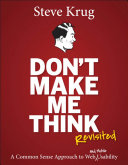

The core principle of usability is that a website or application should be intuitive and easy to navigate. Users should be able to accomplish their goals with minimal effort and confusion. The author emphasizes that when users encounter obstacles or confusion, they are likely to abandon the task altogether. This principle is rooted in the idea that the web is a medium for communication and interaction, and if users have to think too much about how to use a site, they will become frustrated and disengaged. The book provides practical examples and case studies that illustrate how effective usability can lead to higher user satisfaction and increased conversion rates. Designers and developers are encouraged to prioritize user experience by conducting usability tests and iterating on designs based on user feedback.
Continue readingOne of the book's most memorable phrases is 'Don't make me think,' which encapsulates the idea that websites should be self-explanatory. Users should not have to decipher complex navigation or ambiguous labels. The author argues that clarity in design is paramount, and every element on a webpage should serve a purpose that is immediately apparent. This idea extends to content as well; writing should be clear and concise. The book discusses the importance of visual hierarchy, layout, and labeling in guiding users through a site without unnecessary cognitive load. By simplifying the user experience, designers can create a more enjoyable and effective interaction for users.
Continue readingIn a world where users often skim content rather than read it thoroughly, scannability becomes crucial. The author highlights that users typically scan web pages for relevant information rather than reading every word. Therefore, web content should be organized in a way that allows users to quickly find what they’re looking for. This includes using headings, bullet points, and short paragraphs. The book provides strategies for enhancing scannability, such as emphasizing key information and using visual elements to break up text. By understanding how users consume information online, designers can craft content that is both engaging and easy to digest.
Continue readingVisual design is not just about aesthetics; it plays a crucial role in usability. The author discusses how good visual design can enhance user experience by guiding users’ attention and making interactions more intuitive. Elements like color, typography, and spacing can influence how users perceive and interact with a website. The book stresses the importance of consistency in design, which helps users build familiarity and trust. By applying principles of visual design, designers can create interfaces that are not only appealing but also functional and user-friendly. The author provides examples of effective design choices that improve usability.
Continue readingFeedback is an essential component of user interaction. The author explains that users need to know that their actions have been recognized and understood by the system. This includes visual cues, such as highlighting a button when it is clicked, or providing confirmation messages after a form submission. The book emphasizes that effective feedback can prevent user frustration and confusion, as it reassures users that they are on the right track. Designers are encouraged to think about how to communicate status and results to users clearly and effectively, ensuring that users feel in control of their interactions.
Continue readingUser testing is a critical step in the design process that allows designers to gather insights directly from users. The author advocates for iterative design, where prototypes are tested and refined based on user feedback. This approach helps identify usability issues early in the process, allowing designers to make informed decisions that enhance the overall user experience. The book outlines different methods for conducting user tests, including observational studies and usability testing sessions. By prioritizing user testing, designers can create products that truly meet the needs and expectations of their audience.
Continue readingUltimately, the book drives home the point that design should always prioritize the user. This means understanding user needs, preferences, and behaviors and designing with empathy. The author encourages designers to put themselves in the users' shoes and consider their experiences and frustrations. This user-centered approach can lead to more effective design solutions that resonate with users. The book also discusses the importance of accessibility, ensuring that products are usable by people with diverse abilities. By adopting a user-centric mindset, designers can create inclusive and effective products that enhance the overall user experience.
Continue reading